Huawei Technologies G7300A GSM Mobile Phone User Manual Users manual
Huawei Technologies Co.,Ltd GSM Mobile Phone Users manual
Users manual

Copyright © Huawei Technologies Co., Ltd. 2011.
All rights reserved.
Trademarks and Permissions
, , and are trademarks or
registered trademarks of Huawei Technologies Co., Ltd.
Other trademarks, product, service and company names
mentioned are the property of their respective owners.
NO WARRANTY
THE CONTENTS OF THIS MANUAL ARE PROVIDED “AS IS”.
EXCEPT AS REQUIRED BY APPLICABLE LAWS, NO WARRANTIES
OF ANY KIND, EITHER EXPRESS OR IMPLIED, INCLUDING BUT
NOT LIMITED TO, THE IMPLIED WARRANTIES OF
MERCHANTABILITY AND FITNESS FOR A PARTICULAR PURPOSE,
ARE MADE IN RELATION TO THE ACCURACY, RELIABILITY OR
CONTENTS OF THIS MANUAL.
TO THE MAXIMUM EXTENT PERMITTED BY APPLICABLE LAW,
IN NO CASE SHALL HUAWEI TECHNOLOGIES CO., LTD BE
LIABLE FOR ANY SPECIAL, INCIDENTAL, INDIRECT, OR
CONSEQUENTIAL DAMAGES, OR LOST PROFITS, BUSINESS,
REVENUE, DATA, GOODWILL OR ANTICIPATED SAVINGS.
i
Contents
1 Getting to Know Your Phone................................................1
Your Phone ........................................................................................... 1
Keys and Functions ........................................................................... 2
Main Screen Icons ............................................................................. 3
2 Getting Started .......................................................................5
Installing the SIM Card and the Battery................................... 5
Removing the Battery and the SIM Card................................. 5
Installing a microSD Card............................................................... 6
Charging the Battery........................................................................ 6
Calibrating the Screen ..................................................................... 7
Accessing a Shortcut Menu........................................................... 7
Working with the Main Menu ...................................................... 8
Viewing Other Parts of the Home Screen............................... 9
Phone Lock.........................................................................................10
Mass Storage.....................................................................................11
PIN and PUK ......................................................................................12
Locking the Screen..........................................................................13
3 Voice Services ...................................................................... 14
Making a Call.....................................................................................14
Receiving a call .................................................................................15
4 Text Input ............................................................................. 15
Changing the Text Input Mode..................................................15
ii
Multi-Tap Input Mode ...................................................................16
Predictive Input Mode...................................................................17
Entering Digits ..................................................................................18
Entering Symbols.............................................................................18
5 Message ................................................................................ 19
Writing and Sending a Text Message .....................................19
Writing and Sending a Multimedia Message......................19
Backuping or Restoring Text Message and Multimedia
message...............................................................................................21
Viewing the Inbox and Sent Messages ..................................22
6 Email...................................................................................... 23
Creating an Email Account ..........................................................23
Activating an Email Account .......................................................23
Writing and Sending an Email ...................................................23
7 Voice Mail............................................................................. 24
8 Phonebook ........................................................................... 25
Creating a Contact ..........................................................................25
Searching for a Contact ................................................................25
Setting the Preferred Storage.....................................................26
Copying Contacts ............................................................................26
Contact Group...................................................................................27
Backuping or Restoring Contacts .............................................28
9 Multimedia ........................................................................... 28
Camera.................................................................................................28
Video Recorder.................................................................................29
iii
Media Player ......................................................................................30
Image Viewer ....................................................................................31
Photo Editor.......................................................................................31
FM Radio .............................................................................................32
Sound Recorder................................................................................33
Ebook Reader ....................................................................................33
10 WAP Browser ..................................................................... 34
Editing the Data Account .............................................................34
Connecting to the Network ........................................................35
Connecting to a WLAN (Optional)...........................................36
11 Bluetooth............................................................................ 36
Connecting a Bluetooth Headset to Your Phone...............37
Transferring Data .............................................................................37
12 Tools.................................................................................... 38
Alarm.....................................................................................................38
Calendar...............................................................................................38
Tasks ......................................................................................................38
Calculator ............................................................................................39
Unit Converter...................................................................................39
Currency Converter.........................................................................39
World clock ........................................................................................40
Notes.....................................................................................................40
Stopwatch ...........................................................................................40
Backup..................................................................................................41
iv
13 STK ...................................................................................... 41
14 Applications ....................................................................... 41
Installing a Java Application........................................................42
Running a Java Application.........................................................42
Removing a Java Application......................................................43
Facebook .............................................................................................43
Twitter...................................................................................................43
Digital TV (Optional).......................................................................43
Other Applications ..........................................................................44
15 Warnings and precautions ............................................... 44
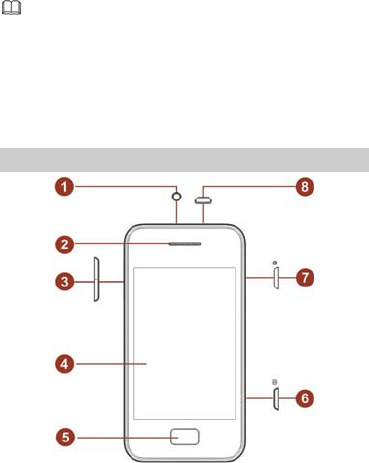
1
Features marked with “optional” are optional. These
features may vary according to service providers. For
details, contact your service provider.
1 Getting to Know Your Phone
Your Phone
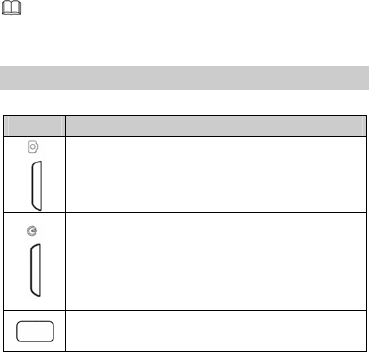
2
1 Headset jack 5 Home key
2 Earpiece 6 Camera shortcut key
3 Volume keys 7 Power key
4 Screen 8 Charger jack/Universal
serial bus (USB) port
The figure above shows the appearance of your phone
and is provided only for your reference.
Keys and Functions
Press… To…
z Press the shortcut key to enter camera function
in standby mode.
z Power the phone on or off (press and hold for
about 3 seconds).
z Lock the screen in standby mode.
z End a call or reject a call.
z Return to the standby mode.
z Return to the standby mode.
z Reject a call.

3
Press… To…
z Increase the volume (by pressing ) or decrease
the volume (by pressing ) during a call.
Main Screen Icons
Icon Indicates…
Signal strength.
Media player enabled.
WLAN connected.
New text messages.
New multimedia messages.
Call forwarding enabled.
Missed calls.
Alarms enabled.
Battery level.
General or My style profile activated.
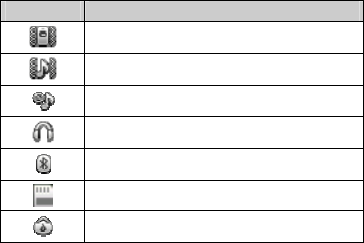
4
Icon Indicates…
Meeting profile activated.
Outdoor profile activated.
Silent profile activated.
Headset connected.
Bluetooth activated.
Memory card inserted.
Stopwatch enabled.
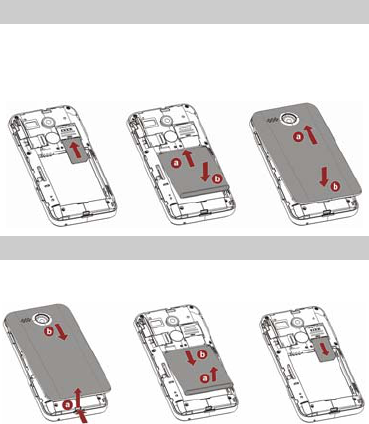
5
2 Getting Started
Installing the SIM Card and the Battery
When installing a SIM card, ensure that the golden contact area
on the SIM card is facing downward and that the beveled edge
of the SIM card is properly aligned with that of the SIM card
slot.
Removing the Battery and the SIM Card
Before removing the battery and the SIM card, ensure that your
phone is powered off.
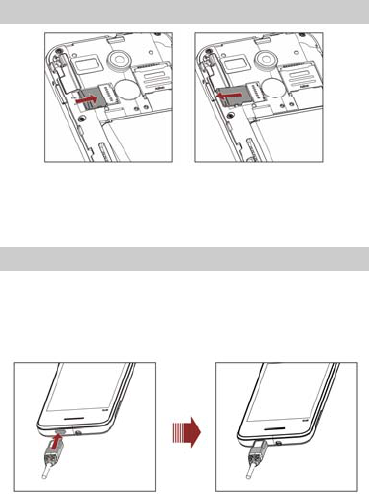
6
Installing a microSD Card
You can install a microSD card to expand the memory capacity
of your phone. When inserting the microSD card, ensure that
the golden contact area on the microSD card is facing
downward.
Charging the Battery
To charge the battery, do the following:
1. Connect the smaller end of the USB cable to the charger jack
on the phone and the larger end to the charger.
2. Connect the charger to a power socket.
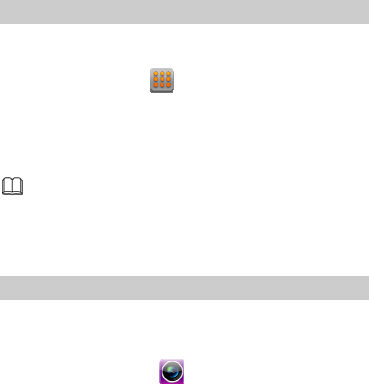
7
3. Wait until the battery is fully charged.
During charging, an animated charging icon is displayed.
When the charging icon is static, the battery is fully charged.
4. Disconnect the charger from the power socket, and then
from the phone.
Calibrating the Screen
The phone responds to the touch of your finger on the screen
accurately after screen calibration.
1. In standby mode, tap and then select Settings > Pen
calibration.
2. Use your finger to tap the three-point marks that appear on
the screen in sequence as prompted to complete screen
calibration.
During the calibration, tap each three-point mark
accurately to ensure that the phone can respond to
your tap and text entry on the screen correctly after
the calibration.
Accessing a Shortcut Menu
In standby mode, there are several default shortcuts are placed
in the bottom of the screen, tap to select the following
shortcuts:
z Access Camcorder: tap to take pictures or record
video clips.
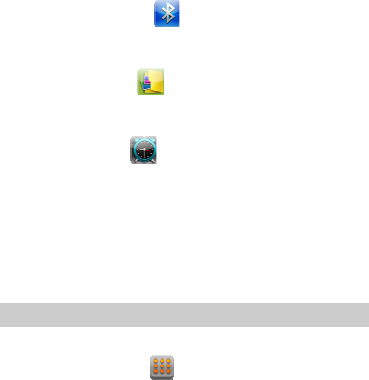
8
z Access Bluetooth: tap to exchange data with other
Bluetooth devices, or connect a Bluetooth headset to your
phone.
z Access My File: tap to organize files stored on your
phone and microSD card. You can view images and photos,
enjoy music and ebooks from My file.
z Access Alarm: tap to set alarms.
An option box will pop up if you press and hold a shortcut for
about 3 seconds. Choose Remove shortcut to delete the
shortcut, or choose Replace shortcut and then select a desired
shortcut in the list of features to replace it.
Features, including applications, that can be set as shortcuts are
listed here: Add contact, Alarm, Bluetooth, Calculator,
Calendar, and so on.
Working with the Main Menu
To work with the main menu, do the following:
1. In standby mode, tap to access the main menu.
2. Slide your finger horizontally across the screen to go to the
next or previous screen, and then tap the desired function to
access it.
3. Slide your finger vertically across the screen to scroll
through options, and then tap the desired submenu to
access it.

9
4. Tap Back or to return to the previous menu.
To return to the standby mode, press or .
Viewing Other Parts of the Home Screen
Slide your finger horizontally across the screen to go to the left
or right screen to view other parts of the home screen. These
extensions to the home screen provide more space for widgets,
shortcuts, and other items. To work with these extensions, do
the following:
z Shortcuts
Tap to add some desired features as shortcut icons and
arrange them in a list. After a shortcut icon is added, you can
tap the icon to access the application directly. You can also
press and hold a shortcut to remove it or replace it.
z Image viewer
View images that saved in the phone or memory card by
flicking your finger to switch between images. Tap one of the
icons below the current image to configure the relevant
settings.
z Favorite contacts
Tap to add favorite contacts to the standby screen.
Once a contact is added, you can add a photo caller ID to
the contact by tapping , call the contact, or send a
message to the contact from the standby screen.
z Weather
Access Weather. You can view weather details in five days.

10
z BBC NEWS
Access BBC NEWS. To confirm the connection to network
when prompted, select YES.
z Media player
Access the media player. Tap to view audio clips and
flick your finger up or down to switch between them.
z Msg viewer
Access Inbox. View abbreviated message in you inbox by
flicking your finger up and down to scroll through the
current message. Tap abbreviated message to view all
message body. Tap the relevant icon below the current
message to write, reply to, or delete a message.
z Recent calls
View all calls and missed calls. You can also make a call, send
a message, add a contact, or replace an existing contact
from a call record.
z Shell settings
Turn Bluetooth and Wireless Fidelity (Wi-Fi) on or off,
activate a profile, and configure settings such as Auto
keypad lock, Wallpaper, and Brightness.
Phone Lock
The phone lock protects your phone from unauthorized use. By
default, the phone lock is disabled. After the phone lock is
enabled, the phone requests the phone code each time it is
powered on.
To enable the phone lock, do the following:
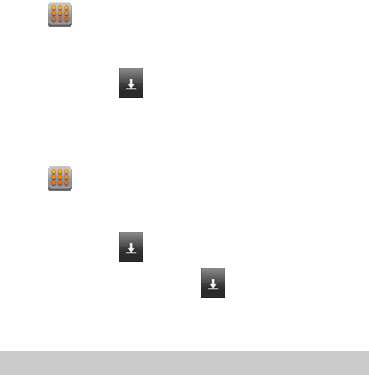
11
1. Tap and then select Settings > Security settings >
Phone security > Phone lock.
2. Tap the text box to open the onscreen keypad, enter the
phone code, tap and then OK.
You can change the default phone code (1234) to any numeric
string of four to eight digits.
To change the phone code, do the following:
1. Tap and then select Settings > Security settings >
Phone security > Change password.
2. Tap the text box to open the onscreen keypad, enter the old
phone code, tap and then OK.
3. Enter the new phone code, tap and then OK.
4. Enter the new phone code again to confirm it.
If you forget the phone code, contact your service provider.
Mass Storage
When the phone is connected to a PC through a USB cable, the
option Mass storage is displayed on the phone screen.
If you select Mass storage, you can manage the files stored in
the phone memory and on the microSD card.
The microSD card and the phone memory are displayed as
removable disks on the PC. You can perform the following
operations:
z Double-click a disk to open it.

12
z Copy, paste, or delete files on the disk.
z Disconnect the phone from the PC.
z Ensure that you connect and disconnect the USB cable
properly.
z Do not run the formatting command on the PC to
format the phone memory; and it may damage the
phone memory permanently.
z You can transfer data and charge the battery by
connecting the phone to the PC through the USB
cable.
PIN and PUK
The personal identification number (PIN) protects your SIM
card from unauthorized use. The PIN unblocking key (PUK)
unlocks the blocked PIN. Both the PIN and the PUK are
provided with the SIM card. For details, contact your service
provider.
To enable the PIN lock, do the following:
1. Tap and then select Settings > Security settings >
SIM security > PIN lock.
2. Tap the text box to open the onscreen keypad, enter the PIN,
tap and then OK.
If you enter incorrect PINs for a specified number of times
consecutively, the phone prompts you to enter the PUK.
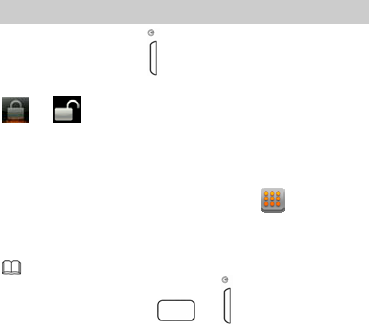
13
If you enter incorrect PUKs for a specified number of times
consecutively, the SIM card becomes permanently invalid. In
this case, contact your service provider for a new SIM card.
Locking the Screen
To lock the screen, press in standby mode. To unlock the
screen, press any key to turn on the backlight, and then slide
to .
If the auto screen lock function is enabled and the phone is in
standby mode for a preset period, the phone locks the screen
automatically.
To enable the auto screen lock function, tap and then
select Settings > Security settings > Auto keypad lock, and
then select the desired duration.
When the keypad is locked, select Answer to answer a
call, or shortly press or to reject a call.
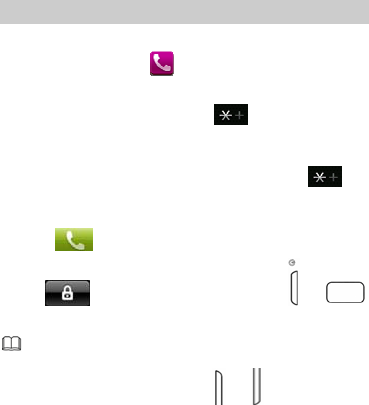
14
3 Voice Services
Making a Call
To make a call, do the following:
1. In standby mode, tap to open the onscreen keypad.
2. Enter the phone number.
z To make an international call, tap twice to enter the
plus sign (+), and then enter the country or region code,
area code, and phone number in sequence.
z To call an extension, enter the phone number, tap
three times to enter P, or four times to enter W, and then
enter the extension number.
3. Press to dial the number.
4. Tap and then select End call or press or
to end the call.
z You can also make calls from the call history,
phonebook, and messages.
z During a call, you can press or to adjust the
in-call volume.
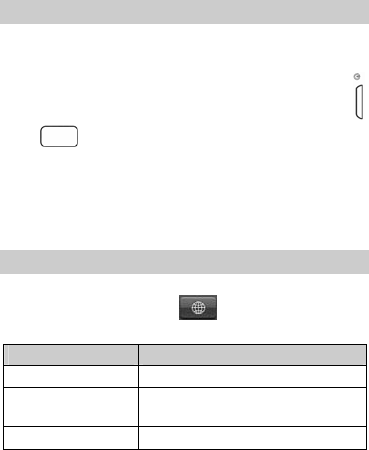
15
Receiving a call
When there is an incoming call, do the following:
z Select Answer to answer the call.
z Tap Silent and then select Reject to reject a call. Or press
or to reject the call.
Tapping Silent can mute the speaker.
4 Text Input
Changing the Text Input Mode
The indicator of the current text input mode is displayed on the
top of the screen. You can tap to select the text input
mode.
Indicator Text Input Mode
ABC, abc, Abc Multi-tap input mode
Smart ABC, Smart
abc, Smart Abc Predictive input mode
Numeric Number input mode
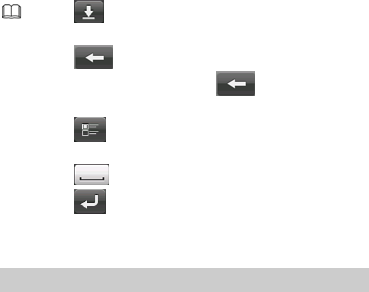
16
z Tap to close the keyboard and tap the text box to
open the keyboard.
z Tap once to delete the last entered character.
You can also touch and hold to clear all the
entered characters at a time.
z Tap to select QWERTY virtual keyboard,
Alphanumeric virtual keyboard or Handwriting.
z Tap to enter a space.
z Tap to add a new paragraph.
z
Multi-Tap Input Mode
In multi-tap input mode, do the following to enter letters:
z When the onscreen keyboard is QWERTY virtual keyboard,
tap the desired letter key.
z When the onscreen keyboard is Alphanumeric virtual
keyboard, tap a key once to enter the first letter labeled on
that key, twice to enter the second letter, and so on.
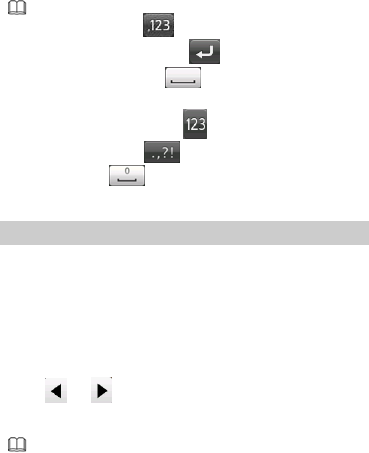
17
z When the onscreen keyboard is QWERTY virtual
keyboard, tap to open the numeric and
symbol keyboard, tap to start a new
paragraph, or tap to enter a space.
z When the onscreen keyboard is Alphanumeric
virtual keyboard, tap to open the numeric
keyboard, tap to open the symbol keyboard,
and tap enter a space.
Predictive Input Mode
In predictive input mode, when the onscreen keyboard is
Alphanumeric virtual keyboard, do the following to enter a
word:
1. Tap each key once according to the spelling sequence of the
desired word.
The phone displays the commonly used words according to
the sequence of key taps.
2. Tap or to scroll left or right.
3. Tap the desired word.
In predictive input mode, if the onscreen keyboard is
QWERTY virtual keyboard, predictive input is not
supported.
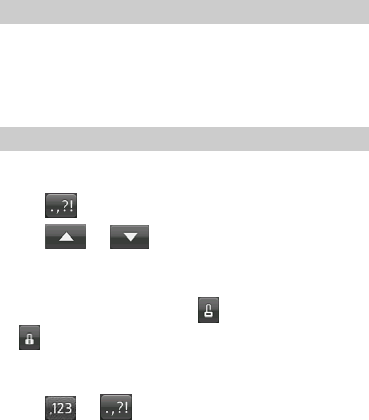
18
Entering Digits
z In number input mode, tap the desired number key.
z In multi-tap input mode, when the onscreen keyboard is
Alphanumeric virtual keyboard, tap the number key labeled
with the desired digit consecutively until the digit appears
on the screen.
Entering Symbols
When the onscreen keyboard is Alphanumeric virtual keyboard,
do the following to enter symbols:
1. Tap to open the symbol keyboard.
2. Tap or to scroll up or down.
3. To enter symbols, do the following:
z To enter only one symbol, tap the desired symbol.
z To enter multiple symbols, tap to change the icon to
and then tap the desired symbols.
When the onscreen keyboard is QWERTY virtual keyboard, do
the following to enter symbols:
1. Tap or to open the symbol keyboard.
2. Tap the desired symbol.

19
5 Message
Writing and Sending a Text Message
To write and send a text message, do the following:
1. Tap to access Message and then select Write
message.
2. Write the message.
3. Tap Options, and then Send to.
4. Tap Enter recipient and enter the phone number of a
recipient; or tap Add from Phonebook and add a recipient
from the phonebook.
To add multiple recipients, repeat this step.
Press or tap Options, and then select one of the following
options:
z Send: to send the message to the recipient.
z Edit recipient: to edit the recipient.
z Remove recipient: to remove the recipient.
z Remove all recipients: to remove all recipients.
z Save: to save the message to Drafts and exit the Write
message screen.
Writing and Sending a Multimedia
Message
To write and send a multimedia message, do the following:

20
1. Tap to access Message and then select Write
message.
2. Write the message.
3. Tap Options to select one of the following options:
z Add picture: to add a picture to the message.
z Add sound: to add an audio clip to the message.
z Add video: to add a video clip to the message.
z Add subject: to add a subject to the message.
z Slide options: to add a slide to the message, set the playing
interval between two slides and so on.
z Switch to MMS: to change from a text message to a
multimedia message.
If you select Add picture, Add sound, Add video, or Add
subject, the message automatically changes from a text
message to a multimedia message.
4. On the Write message screen, press or tap Options, and
select Send to.
5. Tap Enter recipient and enter the phone number of a
recipient; or tap Add from Phonebook and add a recipient
from the phonebook.
To add multiple recipients, repeat this step.
6. Scroll to the desired recipient, press or tap Options, and
select one of the following options:
z Send: to send the message to the recipient.
z Send options: to set the send options.
z Edit recipient: to edit the recipient.

21
z Remove recipient: to remove the recipient.
z Remove all recipients: to remove all recipients.
z Change to Cc: to copy the message to the recipient.
z Change to Bcc: to blind copy the message to the recipient.
z Save to Drafts: to save the message to Drafts and exit the
Write message screen.
z By default, messages are stored in the phone memory.
z For the availability of the Multimedia Messaging Service
(MMS) and the method for subscribing to the service,
please contact your service provider.
z Your phone supports a multimedia message with a
maximum size of 300 KB.
z Open multimedia messages with caution. Objects in
multimedia messages may contain viruses (such as
malicious software) that can damage your phone.
Backuping or Restoring Text Message and
Multimedia message
Tap , select Message > Message settings > Tex t
message backup and restore, select Text message backup
and tap Yes to confirm to backup all text messages to the
memory card. Select Text message restore and tap Yes to
confirm to restore all text messages to phone.
Tap , select Message > Message settings > Multimedia
message backup and restore, select Text message backup
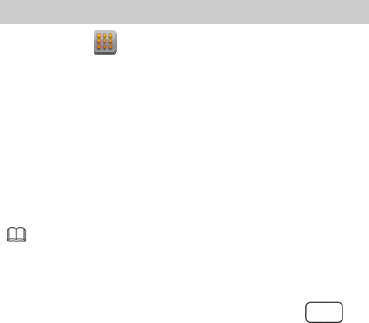
22
and tap Yes to confirm to backup all multimedia messages to
the memory card. Select Multimedia message restore and tap
Yes to confirm to restore all multimedia messages to phone.
Viewing the Inbox and Sent Messages
By default, tap , and then select Message >
Conversations to view your received and sent messages. All
the received and sent message are grouped by contact and
sorted by time.
Select Message > Message settings > Conversations, select
Off to close the conversations and saved your all messages to
the Inbox or the Sent messages respectively. Select Message
> Inbox to view the messages that have been received, or
select Message > Sent messages to view the messages that
have been sent.
z When your phone receives a message, the
corresponding icon appears in the status bar, this icon
will prompt you it is the text message or the
multimedia message.
z When your phone receives a message, press
to return to the standby mode, and then select View to
view it, or select Back. You need to open the
Conservations or Inbox to view the new received
message later.
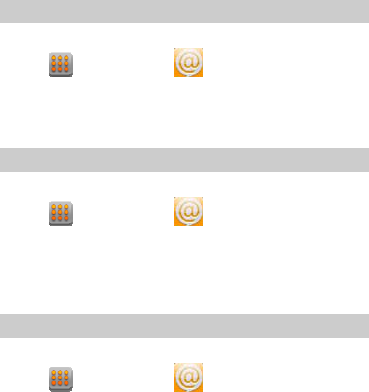
23
6 Email
Before sending or receiving emails, you must create and
activate an email account.
Creating an Email Account
To create an email account, do the following:
1. Tap and then select (Email).
2. Tap the desired type from a list including Gmail, Yahoo,
Hotmail, and Other Email accounts.
3. Set the relevant parameters and save the email account.
Activating an Email Account
To activate an email account, do the following:
1. Tap and then select (Email).
2. Select an email account and tap Options, then tap Email
account.
3. Tap the desired email account and tap Options, then tap Set
as default account to activate the email account.
Writing and Sending an Email
To write and send an email, do the following:
1. Tap and then select (Email).
2. Select an email account to send an email and tap Options,
then tap Write Email.

24
3. Tap To to add the email address of a recipient.
4. Tap Subject to edit the email subject.
5. Tap to add an attachment.
6. Set the email Priority.
7. Tap the text box to edit the email.
8. After editing, tap Options to select one of the following
options:
z Send: to send the email.
z Priority: to set the email priority between High and Low.
z Save to Drafts: to save into Drafts and exit the editor screen.
z Exit: to exit the email editor screen without saving the email.
7 Voice Mail
To add a voicemail number or change the existing voicemail
number, do the following:
1. Tap to access Message and then select Voicemail
server.
2. Tap Options and then tap Edit.
3. Edit the voicemail name and number.
4. Tap OK to save the setting.
To dial the existing voicemail number, do the following:

25
1. Tap to access Message and then select Voicemail
server.
2. Tap the voicemail number, or tap Options and then tap Call
voicemail.
You can also tap in standby mode, and then
touch and hold 1 key to dial the voicemail.
8 Phonebook
Creating a Contact
To create a contact, do the following:
1. Tap or to access Phonebook.
2. Tap Add new contact.
3. Enter the contact information and save the contact.
Searching for a Contact
1. Tap or to access Phonebook.
2. Enter the first letter or number of the contact name in the
text box.
3. Tap to select the desired contact.

26
Setting the Preferred Storage
To select the storage where you want to save new contacts, do
the following:
1. Tap or to access Phonebook.
2. Tap Options and select Phonebook settings > Preferred
storage.
3. Scroll to SIM, Phone, or Both as desired.
4. Tap OK to select the preferred storage.
Copying Contacts
You can copy contacts to the phone, the SIM card, or a file.
Copying One Contact
To copy one contact, do the following:
1. Tap or to access Phonebook.
2. Enter the first letter of the contact name in the text box.
3. Tap the desired contact.
4. Tap Options and select Copy.
5. Select To phone, To SIM, or To file to copy the contact to
the desired location.
Copying Multiple Contacts
To copy multiple contacts, do the following:
1. Tap or to access Phonebook.

27
2. Tap Options and select Phonebook settings > Copy
contacts.
3. Tap the desired option, such as SIM to phone or Phone to
SIM.
4. Tap the desired contacts to mark them, and then tap
Options and select Copy marked.
5. Tap Yes to copy contacts to the desired location.
Contact Group
You can create a contact group, such as family, classmates, or
workmates, and then add relevant contacts to the group. The
members in the group have some common features, such as
Caller ringtone and Caller picture.
To create a contact group, do the following:
1. Tap or to access Phonebook.
2. Tap Options and select Caller groups > Add new group.
3. Set Group name, Caller picture, Caller ringtone, and
Caller video, and then tap Options and select Save.
4. Tap Yes to save the contact group.
To add contacts to a contact group, do the following:
1. Tap or to access Phonebook.
2. Tap Options and select Caller groups.
3. Scroll to the contact group, tap Options and select View
members.
4. Tap Add or tap Options and select Add members and then
select the desired contacts from Phonebook.
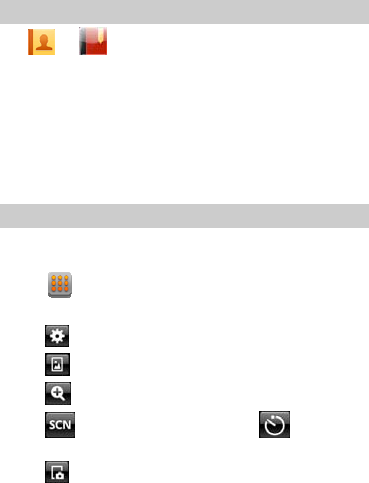
28
5. Tap the desired contacts to add them to the contact group.
Backuping or Restoring Contacts
Tap or to access Phonebook, select Options >
Phonebook settings > Backup contacts, tap Yes to confirm to
backup all contacts to memory card. Select Options >
Phonebook settings > Restore contacts, tap Yes to confirm to
restore all contacts to phone.
9 Multimedia
Camera
The phone features a built-in 5.0-megapixel complementary
metal-oxide-semiconductor (CMOS) camera.
1. Tap and then select Camcorder to access Camera.
2. On the picture taking screen, do the following:
z Tap to configure relevant settings.
z Tap to view photos.
z Tap to zoom in or to zoom out.
z Tap to select Scene mode and tap to configure
Self-timer.
z Tap to select Capture mode.
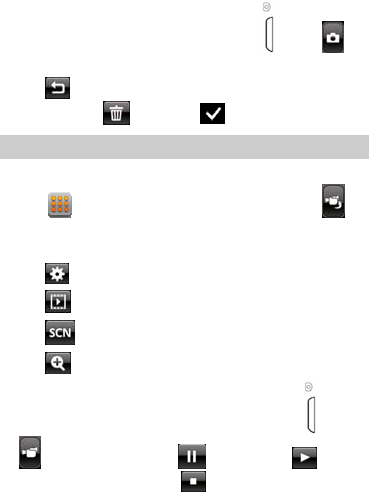
29
3. Focus the camera on the scene and press or tap to
take a picture.
4. Tap to save the picture and then you can take another
picture or tap and select to delete the picture.
Video Recorder
To record a video clip, do the following:
1. Tap and then select Camcorder, and then tap to
switch to Video recorder mode.
2. In video recording mode, you can do the following:
z Tap to configure the relevant settings.
z Tap to play video clip.
z Tap to select Scene mode.
z Tap to zoom in or zoom out.
3. Focus the video recorder on the scene and press or tap
to start recording. Tap to pause, tap to
continue the recording, tap to stop recording.
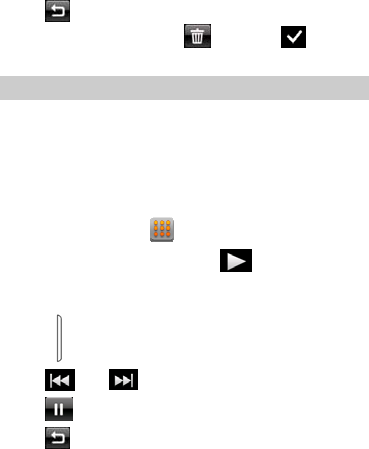
30
4. Tap to save the video clip as instructed and then you
can take another one or tap and select to delete
the video clip.
Media Player
The media player plays audio clips stored in the All songs
folder and video clips stored in the All videos folder in the
phone memory or on the microSD card. To obtain better sound
quality, it is recommended that you use the headset to listen to
those clips.
To play a clip, do the following:
1. In standby mode, tap and then select Media Player.
2. Select Now playing, and then tap to start playing the
clip, or select a video or audio file to play a new clip.
When the clip is being played, you can do the following:
z Press to adjust the volume.
z Tap and to switch between clips.
z Tap to pause playing the clip.
z Tap to go to the previous menu.
All audio and video files are automatically added to Media
player. And you can also manual add an audio or video file to
Media player, do the following:
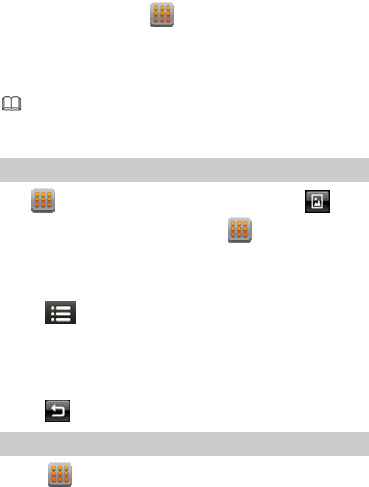
31
1. In standby mode, tap and then select Media Player.
2. Select All songs and tap Options, and then tap Add from
folder to add a audio file from Phone or Memory card. The
method of adding video file is similar.
Only files in .mp4, .3gp, .mp3, .amr and .wmv formats are
supported. Files in other formats may not play.
Image Viewer
Tap and then select Camcorder, and then tap to
access Image Viewer. You can also tap and then select
Image Viewer to access this function. Image Viewer provides
the following options for all pictures in the phone memory and
on the microSD card:
z Tap to View, Edit, Browse style, Send (by MMS ,
Bluetooth or Email), Use as (Wallpaper, Screen saver , Power
on display, Power off display or Caller picture), Rename,
Delete, Sort by (Name, Type, Time, Size or None), Delete all
files and Storage selection.
z Tap to go to the previous menu.
Photo Editor
1. Tap and then select Photo editor.
2. Select Photo artist or Image tiles.
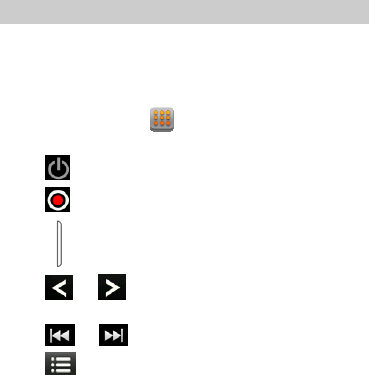
32
3. Edit the image.
You can adjust the image size, and add text, a frame, or a
seal to the image.
4. Select Options > Save as to save the image.
FM Radio
The headset cable also functions as an antenna. To ensure
reception of radio programs, do not disconnect the headset
from the phone or bend the headset cable.
1. Connect the headset to the phone.
2. In standby mode, tap and then select FM radio.
When listening to the radio, you can do the following:
z Tap to stop or continue the playing.
z Tap to record the program.
z Press to adjust the volume.
z Tap or to adjust the frequency at a precision of
0.1 MHz.
z Tap or to switch between channels.
z Tap to view or edit the channel list, manually set a
frequency, automatically search for and save channels,
configure the relevant settings, record the audio clip, and so
on.
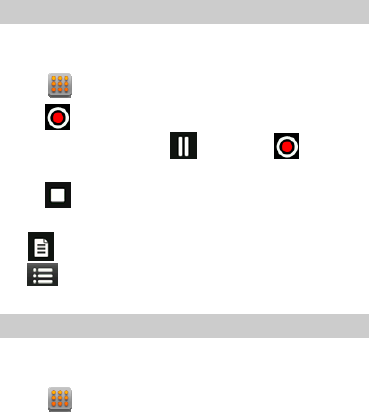
33
Sound Recorder
The sound recorder functions as a digital recorder.
To record an audio clip, do the following:
1. Tap and then select Sound recorder.
2. Tap to record an audio clip.
During the recording, tap to pause or to
continue.
3. Tap to stop recording the audio clip, and then tap Yes
to save the recorded clip as instructed.
Tap to view the list of the recorded files, and you can also
tap to add a new record, view the list of the recorded
files, setting the Storage, File format and Audio quality.
Ebook Reader
Your phone supports ebooks in .txt and .pdb formats.
To read ebooks, do the following:
1. Tap and then select Ebook reader to display the
bookshelf.
The phone automatically adds the ebooks stored in the
default storage location (phone or memory card) to the
bookshelf. Select Options > Global settings > Select
storage to change the default storage location for ebook.
2. Select an ebook.

34
3. Press Options, and then select from the following:
z Global settings: to set the font, scroll type, encoding, and
alignment.
z Open ebook: to start reading the ebook.
4. Press Back to stop reading.
Store ebooks in the Ebook folder in the phone
memory or on the microSD card. If you open an ebook
in another folder, the phone automatically moves the
ebook to the Ebook folder so that you can find it
easily in your next reading.
10 WAP Browser
You can access Wireless Application Protocol (WAP) sites and
use WAP-based services on your phone. To access WAP sites,
you need to subscribe to the service from your service provider
and set the relevant parameters on your phone.
For details about the service and the charges, contact your
service provider.
To access WAP sites, you don’t need to set your data account
and WAP parameters.
Editing the Data Account
Data account is supported by your service provider already
exists, you can also edit it, do the following:

35
1. Tap and then select Connectivity > Data account.
2. Select a existed data account
3. Tap Options and select Edit.
4. Set the parameters based on the information provided by
your service provider.
5. Tap OK and then Yes to save the settings.
Connecting to the Network
You can browse WAP pages on your phone. To access a website,
do the following:
1. Tap and then select Opera mobile.
2. Tap the website box to enter a Uniform Resource Locator
(URL) address.
3. Tap to close the keyboard and select Go to access
the website. Tap to stop.
4. Tap , You can do the following:
z Bookmarks: to select a WAP site address from the list, and
then tap to open.
z History: to display the history page.
z Start Page: to return to the start page.
z Save Pages: to keep the current page into this open folder.
z Downloads: to manage your download files or applications.
z Settings: to manually set relevant parameters.
z Exit: to exit Opera mobile.

36
Connecting to a WLAN (Optional)
1. Tap and then select WLAN.
Your phone will automatically search for available WLAN
network and list them.
2. Select a WLAN network, tap Options > Connect to connect
it. If you access this WLAN network at the first time, it will
prompt you to enter the WEP key.
3. Tap Options, You can do the following:
z Connect: to connect to the selected WLAN.
z Add: to manually enter relevant parameters to add a new
wireless LAN network.
z Define access point: to view or edit the list of the wireless
LAN networks to which you selected.
z WLAN status: to view your phone’s MAC address.
z Disable WLAN: to turn off WLAN.
z Refresh: to search for available wireless LAN networks.
11 Bluetooth
The Bluetooth function enables you to exchange data with
other Bluetooth devices, and connect a Bluetooth headset to
your phone.
You can turn on the Bluetooth function by configuring
Bluetooth settings.

37
Connecting a Bluetooth Headset to Your
Phone
To connect a Bluetooth headset to your phone, do the
following:
1. Tap and then select Bluetooth > Power, and then tap
On to turn on the Bluetooth function.
2. Select Search audio device to search for available Bluetooth
headsets.
3. Scroll to the desired Bluetooth headset and tap Pair.
4. Enter the password to pair the Bluetooth headset with your
phone.
When the Bluetooth headset is connected to your phone, the
headset icon is displayed on the standby screen indicating that
you can use the headset.
No Bluetooth headset is included in the product
package. If you need a Bluetooth headset, please
purchase one separately.
Transferring Data
To transfer data, do the following:
1. Tap and then select Bluetooth > Power, and then tap
On to turn on the Bluetooth function.
2. Select My device > Search new device to search for
available Bluetooth devices.
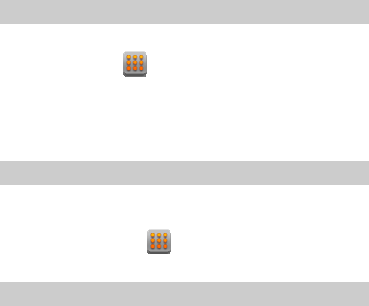
38
3. Scroll to the desired Bluetooth device and tap Pair.
When the Bluetooth device is connected to your phone for
the first time, you need to enter the password to pair it with
your phone.
4. Transfer data between your phone and the Bluetooth device.
12 Tools
Alarm
You can set five alarms on your phone.
To set an alarm, tap and then select Alarm in standby
mode, enable or disable the alarm, and then set the alert time,
repeat mode, alarm tone, snooze duration, and alert type.
Once the alarm is enabled, the alarm icon is displayed on the
standby screen.
Calendar
You can add events to the calendar and keep track of important
events.
To access Calendar, tap and then select Calendar in
standby mode.
Tasks
You can add tasks to the phone. You can also view, edit, and
delete tasks as desired.
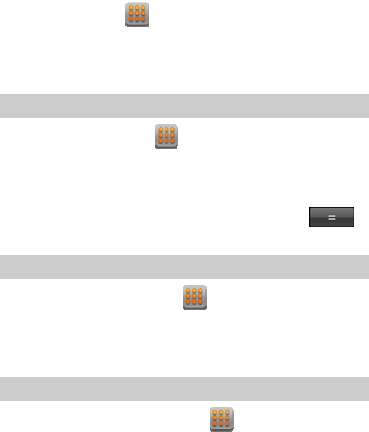
39
To access Tasks, tap and then select Tas ks in standby
mode.
Once a task is enabled, and the preset time arrives, the phone
rings as a reminder.
Calculator
To access Calculator, tap and then select Calculator in
standby mode.
To calculate, enter the number to be calculated, select a
mathematical operation by tapping the corresponding key,
enter another number to be calculated, and then tap
obtain the result.
Unit Converter
To access Unit Converter, tap and then select Unit
converter in standby mode.
Tap Weight or Length, select the unit, enter the value, tap and
then tap OK to obtain the result.
Currency Converter
To access Currency converter, tap and then select
Currency converter in standby mode.
Enter the rate, tap and then tap OK. Enter the local currency
value, and then tap OK to obtain the result.
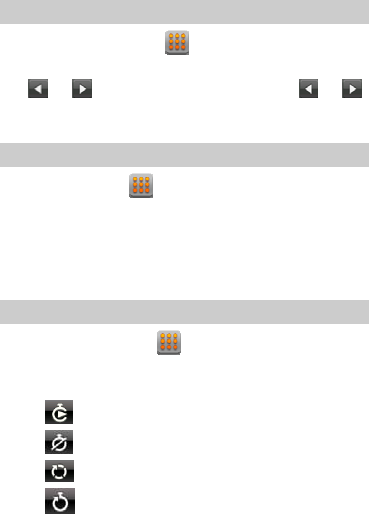
40
World clock
To access World clock, tap and then select World clock
in standby mode.
Tap or to select a time zone and then tap or
to select a city or country that you desired, the time and date of
the city or the country will display on the screen.
Notes
To access Notes, tap and then select Notes in standby
mode.
The notes function is similar to providing personal pen and
paper for you, and helps you record important notepads at any
time. Tap a note to view it. Select Options, you can new, edit,
mark or delete a note.
Stopwatch
To access Stopwatch, tap and then select Stopwatch in
standby mode.
To use stopwatch, do the following:
1. Tap to start.
2. Tap to pause.
3. Tap to record the time one by one.
4. Tap to clear the stopwatch.
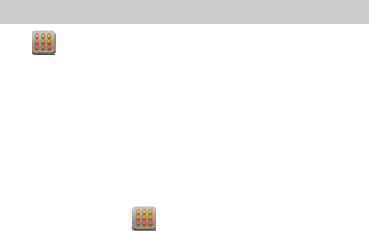
41
Backup
Tap and then select Backup. Select Backup to memory
card can backup contacts, text messages and multimedia
messages to memory card. Select Restore from memory card
can restore contacts, text messages and multimedia messages
to phone.
13 STK
In standby mode, tap to access the main menu and then
select STK.
The SIM Tool Kit (STK) function is available only if your service
operator provides it. It is a value-added service that allows you
to send text messages, read news, and use other applications.
For details, contact your service operator.
14 Applications
You can install third-party Java applications to expand the
capabilities of your phone.

42
z Not all Java applications are compatible with your
phone. If you have trouble in installing or running a
Java application, press to return to the standby mode,
and then remove the application from your phone.
z Certain Java applications require network connections.
Therefore, ensure that the GPRS connection is properly
set up.
Installing a Java Application
To install a Java application on your phone, do the following:
1. Select a Java installation file in .jar or .jad format from Phone
or Memory card, tap Options, and then select Install to
start the installation.
2. Tap Yes to confirm the certification information.
3. Select Phone or Memory card to install the Java application.
When the installation is completed successfully, the message
"Installed" is displayed.
Running a Java Application
To run a Java application, do the following:
1. Tap and then select Java.
2. Select a Java application and tap Options.
3. Select Launch to run the Java application.

43
Removing a Java Application
To remove a Java application installed on your phone, do the
following:
1. Tap and then select Java.
2. Select a Java application and tap Options.
3. Select Delete to remove the application.
4. Tap Yes to confirm the certification information.
After the Java application is removed, the message
"Deleted" is displayed.
Facebook
To log on the Facebook, the third-party Java application, tap
and select Facebook and then follow the options
available.
Twitter
To log on the Twitter, the third-party Java application, tap
and select Twitter and then follow the options available.
Digital TV (Optional)
Tap and then select Digital TV.
Every time you enter Digital TV, it will automatically search for
available TV programs.
Tap Menu to display and highlight the available options, and
you can choose to save your favorite channels or programs.

44
Other Applications
Tap to enter main menu and then you can select Opera
Mini, Gtalk, MSN, General Mail, Google Search, and so on.
15 Warnings and precautions
This section contains important information pertaining to the
operating instructions of your device. It also contains
information about how to use the device safely. Read this
information carefully before using your device.
Electronic Device
Power off your device if using the device is prohibited. Do not
use the device when using the device causes danger or
interference with electronic devices.
Medical Device
z Follow rules and regulations set forth by hospitals and
health care facilities. Do not use your device when using the
device is prohibited.
z Pacemaker manufacturers recommend that a minimum
distance of 15 cm be maintained between a device and a
pacemaker to prevent potential interference with the
pacemaker. If you are using a pacemaker, use the device on
the opposite side of the pacemaker and do not carry the
device in your front pocket.
45
Potentially Explosive Atmosphere
Power off your device in any area with a potentially explosive
atmosphere, and comply with all signs and instructions. Areas
that may have potentially explosive atmospheres include the
areas where you would normally be advised to turn off your
vehicle engine. Triggering of sparks in such areas could cause
an explosion or a fire, resulting in bodily injuries or even deaths.
Do not power on your device at refueling points such as service
stations. Comply with restrictions on the use of radio
equipment in fuel depots, storage, and distribution areas, and
chemical plants. In addition, adhere to restrictions in areas
where blasting operations are in progress. Before using the
device, watch out for areas that have potentially explosive
atmospheres that are often, but not always, clearly marked.
Such locations include areas below the deck on boats, chemical
transfer or storage facilities, and areas where the air contains
chemicals or particles such as grain, dust, or metal powders.
Ask the manufacturers of vehicles using liquefied petroleum
gas (such as propane or butane) whether this device can be
safely used in their vicinity.
Traffic Security
Observe local laws and regulations while using the device. In
addition, if using the device while driving a vehicle, comply with
the following guidelines:
z Concentrate on driving. Your first responsibility is to drive
safely.
z Do not talk on the device while driving. Use hands-free
accessories.
46
z When you have to make or answer a call, park the vehicle at
the road side before using your device.
z RF signals may affect electronic systems of motor vehicles.
For more information, consult the vehicle manufacturer.
z In a motor vehicle, do not place the device over the air bag
or in the air bag deployment area. Otherwise, the device
may hurt you owing to the strong force when the air bag
inflates.
z Do not use your device while flying in an aircraft. Power off
your device before boarding an aircraft. Using wireless
devices in an aircraft may cause danger to the operation of
the aircraft and disrupt the wireless telephone network. It
may also be considered illegal.
Operating Environment
z Do not use or charge the device in dusty, damp, and dirty
places or places with magnetic fields. Otherwise, it may
result in a malfunction of the circuit.
z The device complies with the RF specifications when the
device is used near your ear or at a distance of 1.5 cm from
your body. Ensure that the device accessories such as a
device case and a device holster are not composed of metal
components. Keep your device 1.5 cm away from your body
to meet the requirement earlier mentioned.
z On a stormy day with thunder, do not use your device when
it is being charged, to prevent any danger caused by
lightning.
z When you are on a call, do not touch the antenna. Touching
the antenna affects the call quality and results in increase in
47
power consumption. As a result, the talk time and the
standby time are reduced.
z While using the device, observe the local laws and
regulations, and respect others' privacy and legal rights.
z Keep the ambient temperature between 0°C and 40°C while
the device is being charged. Keep the ambient temperature
between 0°C to 40°C for using the device powered by a
battery.
Prevention of Hearing Damage
Using a headset at high volume can damage your hearing. To
reduce the risk of damage to hearing, lower the headset
volume to a safe and comfortable level.
Safety of Children
Comply with all precautions with regard to children's safety.
Letting the child play with your device or its accessories, which
may include parts that can be detached from the device, may
be dangerous, as it may present a choking hazard. Ensure that
small children are kept away from the device and accessories.
Accessories
Use the accessories delivered only by the manufacturer. Using
accessories of other manufacturers or vendors with this device
model may invalidate any approval or warranty applicable to
the device, result in the non-operation of the device, and cause
danger.
Battery and Charger
z Unplug the charger from the electrical plug and the device
when not in use.
48
z The battery can be charged and discharged hundreds of
times before it eventually wears out. When the standby time
and the talk time are shorter than the normal time, replace
the battery.
z Use the AC power supply defined in the specifications of the
charger. An improper power voltage may cause a fire or a
malfunction of the charger.
z Do not connect two poles of the battery with conductors,
such as metal materials, keys, or jewelries. Otherwise, the
battery may be short-circuited and may cause injuries and
burns on your body.
z Do not disassemble the battery or solder the battery poles.
Otherwise, it may lead to electrolyte leakage, overheating,
fire, or explosion.
z If battery electrolyte leaks out, ensure that the electrolyte
does not touch your skin and eyes. When the electrolyte
touches your skin or splashes into your eyes, wash your eyes
with clean water immediately and consult a doctor.
z If there is a case of battery deformation, color change, or
abnormal heating while you charge or store the battery,
remove the battery immediately and stop using it. Otherwise,
it may lead to battery leakage, overheating, explosion, or
fire.
z If the power cable is damaged (for example, the cord is
exposed or broken), or the plug loosens, stop using the
cable at once. Otherwise, it may lead to an electric shock, a
short circuit of the charger, or a fire.
z Do not dispose of batteries in fire as they may explode.
Batteries may also explode if damaged.
49
z Danger of explosion if battery is incorrectly replaced. Recycle
or dispose of used batteries according to the local
regulations or reference instruction supplied with your
device.
Cleaning and Maintenance
z The device, battery, and charger are not water-resistant.
Keep them dry. Protect the device, battery, and charger from
water or vapor. Do not touch the device or the charger with a
wet hand. Otherwise, it may lead to a short circuit, a
malfunction of the device, and an electric shock to the user.
z Do not place your device, battery, and charger in places
where they can get damaged because of collision. Otherwise,
it may lead to battery leakage, device malfunction,
overheating, fire, or explosion.
z Do not place magnetic storage media such as magnetic
cards and floppy disks near the device. Radiation from the
device may erase the information stored on them.
z Do not leave your device, battery, and charger in a place
with an extreme high or low temperature. Otherwise, they
may not function properly and may lead to a fire or an
explosion. When the temperature is lower than 0°C,
performance of the battery is affected.
z Do not place sharp metal objects such as pins near the
earpiece. The earpiece may attract these objects and hurt
you when you are using the device.
z Before you clean or maintain the device, power off the
device and disconnect it from the charger.
50
z Do not use any chemical detergent, powder, or other
chemical agents (such as alcohol and benzene) to clean the
device and the charger. Otherwise, parts of the device may
be damaged or a fire can be caused. You can clean the
device and the charger with a piece of damp and soft
antistatic cloth.
z Do not dismantle the device or accessories. Otherwise, the
warranty on the device and accessories is invalid and the
manufacturer is not liable to pay for the damage.
Emergency Call
You can use your device for emergency calls in the service area.
The connection, however, cannot be guaranteed in all
conditions. You should not rely solely on the device for
essential communications.
Certification Information (SAR)
This device meets guidelines for exposure to radio waves.
Your device is a low-power radio transmitter and receiver. As
recommended by international guidelines, the device is
designed not to exceed the limits for exposure to radio waves.
These guidelines were developed by the independent scientific
organization International Commission on Non-Ionizing
Radiation Protection (ICNIRP) and include safety measures
designed to ensure safety for all users, regardless of age and
health.
The Specific Absorption Rate (SAR) is the unit of measurement
for the amount of radio frequency energy absorbed by the
body when using a device. The SAR value is determined at the
highest certified power level in laboratory conditions, but the

0.040W/kg.
worn on the body is 0.558 W/kg.
type when tested at the ear is 0.347 W/kg, and when properly
, also the WIFI is
properly worn on the body is 1.010 W/kg
type when tested for use at the ear is 0.609 W/kg, and when
51
actual SAR level of the device when being operated can be well
below the value. This is because the device is designed to use
the minimum power required to reach the network.
The SAR limit adopted by USA and Canada is 1.6
watts/kilogram (W/kg) averaged over one gram of tissue. The
highest SAR value reported to the FCC and IC for this device
The SAR limit also adopted by Europe is 2.0 W/kg averaged
over 10 grams of tissue. The highest SAR value for this device
Disposal and Recycling Information
This symbol on the device (and any included batteries)
indicates that they should not be disposed of as normal
household garbage. Do not dispose of your device or batteries
as unsorted municipal waste. The device (and any batteries)
should be handed over to a certified collection point for
recycling or proper disposal at the end of their life.
For more detailed information about the recycling of the device
or batteries, contact your local city office, the household waste
disposal service, or the retail store where you purchased this
device.
52
The disposal of this device is subject to the Waste from
Electrical and Electronic Equipment (WEEE) directive of the
European Union. The reason for separating WEEE and batteries
from other waste is to minimize the potential environmental
impacts on human health of any hazardous substances that
may be present.
Reduction of Hazardous Substances
This device is compliant with the EU Registration, Evaluation,
Authorisation and Restriction of Chemicals (REACH) Regulation
(Regulation No 1907/2006/EC of the European Parliament and
of the Council) and the EU Restriction of Hazardous Substances
(RoHS) Directive (Directive 2002/95/EC of the European
Parliament and of the Council). For more information about the
REACH compliance of the device, visit the Web site
www.huaweidevice.com/certification. You are recommended to
visit the Web site regularly for up-to-date information.
FCC Statement
This equipment has been tested and found to comply with the
limits for a Class B digital device, pursuant to Part 15 of the FCC
Rules. These limits are designed to provide reasonable
protection against harmful interference in a residential
installation. This equipment generates, uses and can radiate
radio frequency energy and, if not installed and used in
accordance with the instructions, may cause harmful
interference to radio communications. However,there is no
guarantee that interference will not occur in a particular
installation.If this equipment does cause harmful interference
to radio or television reception,which can be determined by
turning the equipment off and on, the user is encouraged to try

Wi-Fi: 0.040W/kg
Body: 1.010 W/kg
SAR Value: Head:
53
to correct the interference by one or more of the following
measures:
z Reorient or relocate the receiving antenna.
z Increase the separation between the equipment and
receiver.
z Connect the equipment into an outlet on a circuit different
from that to which the receiver is connected.
z Consult the dealer or an experienced radio/TV technician for
help.
This device complies with Part 15 of the FCC Rules. Operation is
subject to the following two conditions: (1) this device may not
cause harmful interference, and (2) this device must accept any
interference received, including interference that may cause
undesired operation.
Warning: Changes or modifications made to this device not
expressly approved by Huawei Technologies Co., Ltd. may void
the FCC authorization to operate this device.
EU Regulatory Conformance
Hereby, Huawei Technologies Co., Ltd. declares that this device
is in compliance with the essential requirements and other
relevant provisions of Directive 1999/5/EC.
For the declaration of conformity, visit the Web site
www.huaweidevice.com/certification.
Notice: Observe the national local regulations in the location
where the device is to be used. This device may be restricted for
use in some or all member states of the European Union (EU).
0.609W/kg
54
Notice: This device may be operated in all member states of the
EU.
France: Outdoor use limited to 10 mW e.i.r.p. within the band
2454-2483.5 MHz.
Italy: For private use, a general authorisation is required if
WAS/RLAN’s are used outside own premises. For public use, a
general authorisation is required.
Luxembourg: General authorisation required for network and
service supply.
Norway: This subsection does not apply for the geographical
area within a radius of 20 km from the centre of Ny-Ålesund.
Version: 01 NO.:
6010588
This device was tested for typical body-worn operations.
To comply with RF exposure requirements, a minimum
separation distance of 15mm must be maintained
between the user's body and the handset, including
the antenna. Third-party belt-clips, holsters, and
similar accessories used by this device should not
contain any metallic components. Body-worn
accessories that do not meet these requirements
may not comply with RF exposure requirements
and shall be avoided.